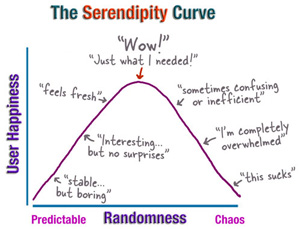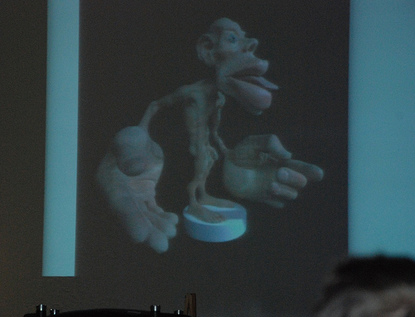Archive for March 11, 2008
Wooing
Tools for Enchantment: 20 Ways to Woo Users
Kathy Sierra, Creating Passionate Users
I entered a room that was the largest out of the entire center – about 1k capacity. I was instantly enthusiastic for the panel to begin. Before I dive into the different ways, Kathy Sierra is a programming instructor and a game developer, so not all 20 points may be applicable to us.
Sierra started the panel by talking about the more the user knows, the more richer the experience becomes. This might sound general, but it’s completely true. For example, the Whitney t-shirt website concept for Summer…if the user does not know how to navigate the site (simply mousing over the circles that will expand to other circles full of information), the user will be completely fed up and leave the site. But, if she finds out how to navigate, she’ll understand and appreciate the website much more, thus, having a richer experience and enjoying it.
Here are the 20 ways to woo users:
1. Use Telepathy. You must experience the users’ experience. With our website, this might become “easy.” We have beta links that enable us to see how the user will see the creative. So, we test out every single combination of clicking to make sure everything is working correctly and have the experience of how the user will engage the content.
2. Serendipity. Add randomness. We tend to find patterns and reasons for everything, but if we add randomness, it engages us a lot more and keeps us interested.
3. The dog ears design principle. Use real world physics (a dog’s ears move separately from it’s head). This subtle little real world experience enhances the user experience and adds human-ness.
4. Create joy. We usually play, learn and then practice. To keep us engaging, we need to create joy in the experience.
5. Inspire first person language Talk about yourself. For example, “I love these Surplus Khakis! I can wear them with my woven shirt or add a blazer.” This type of language helps the reader relate better to the product, therefore, trusting it more. She thinks, “Hey, this person is just like me, I can trust her judgment.”
6. T-shirt first development. This is the thought of making the t-shirt before you make the product. Passionate people will express it with all those souvenirs – t-shirts, stickers, mugs, pens, mousepads, etc. (I’m not quite sure how we can incorporate this to Gap…)
7. Easter eggs and other treats. I personally really love this idea. I believe we can add easter eggs in our site that will surprise the user. Imagine finding a $20 in your jeans months later, doesn’t that feel good? This is the same type of feeling a user will feel when they discover an easter egg. They’ll appreciate the website more and want to look for more treasures.
8. You are a….predator. Manage the users fight or flight response. We all get stressed when we’re under attack, so think about ways to helps users de-stress – help them manage this. For example, Gap Japan’s site for holiday had these scissors that wiggled back and forth. Upon arrival, one might not know what to do, but by adding a movement to the scissors, the user was able to not “stress” out about what to do, but knew to click/interact with the scissors to go to the next destination. At this point, Sierra showed the “Stress Eraser.” A real tool she uses that relieves stress.
10. Exercise the brain. The number one way to help the brain grow is by exercising – help people improve their body. Sierra mentioned the success of Nike+. It is a site that helped the users improve their bodies in an educational and efficient way. Brain Age is also the number one game sold on Amazon. The game has puzzles to “grow” your brain. It’s extremely addicting and fun, by the way.
11. Give them superpowers quickly. Think about how you can enable the user quickly. The user must do something cool within 30 minutes. Obviously, 30 minutes is not going to work on Gap.com, but within the first few seconds, we should have the user do something interesting.
12. Speed their knowledge. Help and keep people pushing forward. Use patterns to help. This can come in the form of consistency of our shops. A really good example is the gifting shops. We had one template that all sub-brands utilized. The user can experience women’s first and then click on men’s. She will quickly already know that she will navigate the men’s shop the same way she did with women’s.
13. Focus. Help them focus on the product. By helping them do this, users will keep engaging and stay longer on the product.
14. Make your product that documents feelings. Have tools that let the users reflect the product. A good example of this are the reviews on Amazon, Target, even Macy’s. The product reviews is a way that users can say whether they liked a certain thing or not, or even to share information.
15. Reinvest mental resources into new problems. Experts of anything never stop learning. It’s the passion to keep learning and to expand their knowledge. So, you would add new skills to help them learn and grow.
16. Create a culture of support. There are no dumb questions or answers. There should be a platform to let people ask and answer questions (forum).
17. Do not insist on “inclusivity.” Passionate users “talk differently.” You should separate the newbies from experts.
18. Practice seductive opacity. Turn the brain on! Mystery. Anticipation. Curiosity. All things the brain loves. The digital world has raised the value of non-physical things (virtual gifts on FB). When you see that distinctive branded packaging (Piperlime, Amazon, Urban Outfitters, etc.), you have an instant feeling of happiness. Here, Sierra mentioned a video/photo site called “Unboxing.com,” where you see the experience of opening something. It’s actually really funny how into it people are.
19. Atoms are not “old skool.” People have senses. Real things that you can touch are very important. This is why there is a sudden spike of DIY magazines/tv shows/websites (etsy.com). The photo below shows which body parts that are the most used. Is there a way we can do this in the digital world?
20. Do everything this guy does. Special surprise guest, Gary Vaynerchuk of Wine Library (a podcast that showcases different types of wine) comes onto the stage and has a five minute speech about wine. Apparently, Sierra is a huge fan of Vaynerchuk and thinks he touches all these points.
I’ve realized this has become an extremely long post, which I did not intend it to be – there’s just so much information! Thanks for reading and I hope you learned something. At the very least, enjoyed looking at the pictures and fun site references. :)


